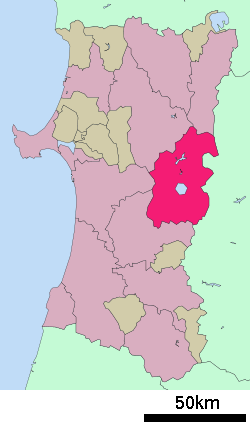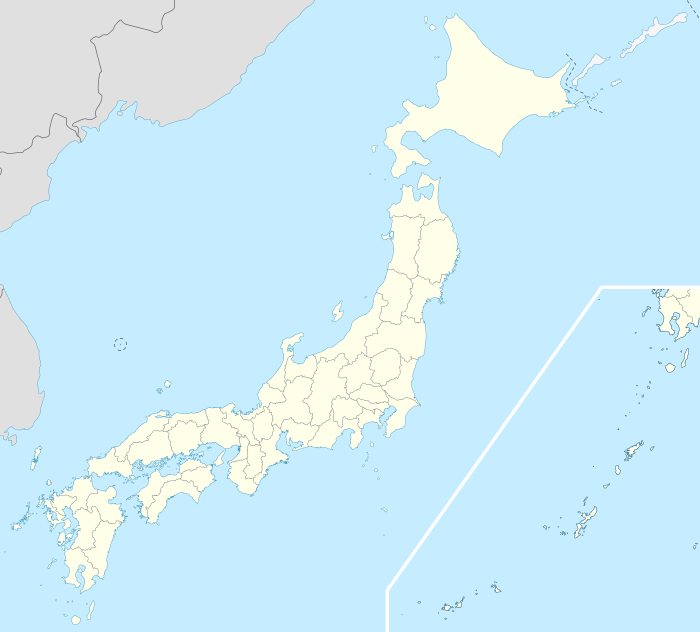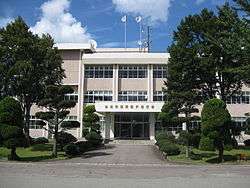Semboku, Akita
| Semboku 仙北市 | |||
|---|---|---|---|
| City | |||
|
Semboku City Hall | |||
| |||
 Location of Semboku in Akita Prefecture | |||
 Semboku
| |||
| Coordinates: 39°42′06″N 140°43′53.4″E / 39.70167°N 140.731500°ECoordinates: 39°42′06″N 140°43′53.4″E / 39.70167°N 140.731500°E | |||
| Country | Japan | ||
| Region | Tōhoku | ||
| Prefecture | Akita Prefecture | ||
| Area | |||
| • Total | 1,093.64 km2 (422.26 sq mi) | ||
| Population (December 2014) | |||
| • Total | 27,663 | ||
| • Density | 25.3/km2 (66/sq mi) | ||
| Time zone | Japan Standard Time (UTC+9) | ||
| Phone number | 0187-43-1111 | ||
| Address | 30 Miyanoshiro, Obonai, Tazawako, Semboku-shi, Akita-ken 014-1201 | ||
| Website | Official website | ||
Semboku (仙北市 Semboku-shi) is a city located in Akita Prefecture, Japan.
As of December 2014, the city has an estimated population of 27,663 and a population density of 25.3 persons per km². The total area is 1,093.64 square kilometres (422 sq mi).
Geography
Semboku is located in the mountains of central Akita Prefecture, bordering on Iwate Prefecture and the Ou Mountains on the east. Part of the city is within the borders of the Towada-Hachimantai National Park.
Neighboring municipalities
- Akita Prefecture
- Iwate Prefecture
Climate
Semboku has a Humid continental climate (Köppen climate classification Cfa) with large seasonal temperature differences, with warm to hot (and often humid) summers and cold (sometimes severely cold) winters. Precipitation is significant throughout the year, but is heaviest from August to October.
History
The area of present-day Semboku was part of ancient Dewa Province. During the Edo period, the area came under the control of the Satake clan, who had been relocated to Kubota Domain from their former holdings in Hitachi Province. After the start of the Meiji period, the area became part of Semboku District, Akita Prefecture in 1878.
The modern city of Semboku was established on March 22, 2005, from the merger of the towns of Kakunodate and Tazawako, and the village of Nishiki (all from Semboku District).
Economy
The economy of Semboku is based on agriculture, forestry and seasonal tourism.
Transportation
Railway
- JR East - Akita Shinkansen
- JR East - Tazawako Line
- Tazawako - Sashimaki - Jindai - Shōden - Kakunodate
- Akita Nairiku Jūkan Railway - Akita Nairiku Line
- Tozawa - Kami-Hinokinai - Sadōri - Ugo-Nakazato - Matsuba - Ugo-Nagatoro - Yatsu - Saimyoji - Ugo-Ōta - Kakunodate
Highway
Local attractions
 Buke-yashiki (samurai residences) street, Kakunodate
Buke-yashiki (samurai residences) street, Kakunodate
- Tamagawa Hot Spring has the highest flow rate of any hot spring in Japan at 150 liters/second, which feeds a 3 meter wide stream with a temperature of 98 degrees C. The water from Tamagawa Hot Spring is also very acidic.
- Towada-Hachimantai National Park
- Lake Tazawa – the deepest lake in Japan
- Ōfuka Onsen
- Kakunodate samurai residences
International relations
Twin towns — Sister cities
Semboku is twinned with:
-
 Ōmura, Nagasaki, Japan, since July 18, 1979
Ōmura, Nagasaki, Japan, since July 18, 1979 -
 Sanuki, Kagawa, Japan, since September 28, 1996
Sanuki, Kagawa, Japan, since September 28, 1996 -
 Shinjō, Yamagata, Japan, since July 27, 1996
Shinjō, Yamagata, Japan, since July 27, 1996 -
 Takahagi, Ibaraki, Japan, since July 27, 1996
Takahagi, Ibaraki, Japan, since July 27, 1996 -
 Hitachiōta, Ibaraki, Japan, since November 21, 1998
Hitachiōta, Ibaraki, Japan, since November 21, 1998
Noted people from Semboku
- Ayako Fuji - musician
- Norihisa Satake – politician
- Shigehiro Taguchi - basketball player
External links
| Wikimedia Commons has media related to Semboku, Akita. |
- Semboku City official website (Japanese)
- Semboku Sightseeing Info (English)
- Old Semboku Town website (Japanese)


